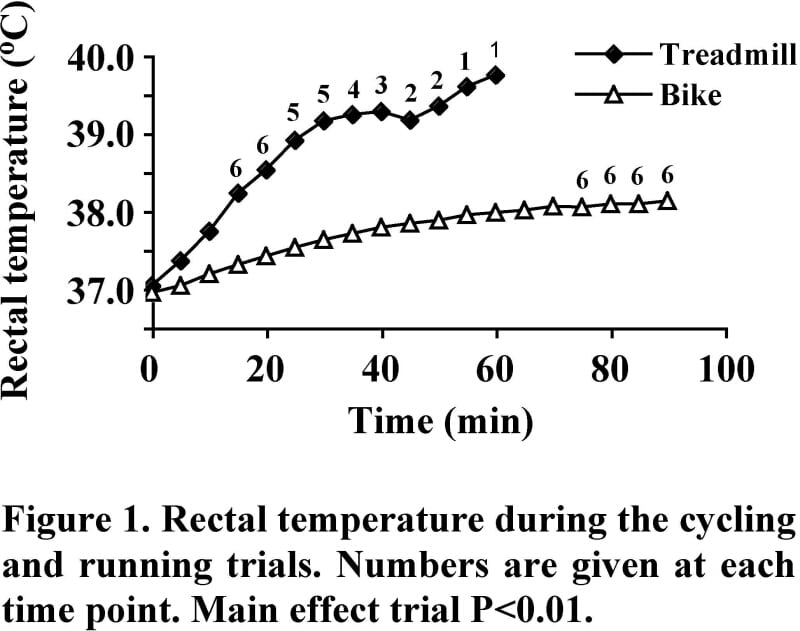Heat acclimation for athletes often occurs on cycle ergometers due to the limited size of environmental chambers and the convenience of being able to acclimatise several members of a team simultaneously. It has been established that a high deep body temperature is a key stimulus in the rate and extent of adaptations that occur in the body (Nielsen et al., 1997). Thus the aim of the present study was to test the hypothesis that deep body temperature will rise at a faster rate during steady rate running than cycling in the heat (30oC, 50% RH). After University ethical approval had been obtained, seven recreationally active males volunteered for the study. The VO2 max for the treadmill was 55.7 ± 2.6 ml.kg-1.min-1 and VO2 max for the cycle ergometer was 46.5 ± 1.6 ml.kg-1.min-1. The volunteers completed a speed-lactate test for determination of lactate threshold (LT) and max test on a treadmill (Powerjog) and cycle ergometer (Monark). The running speeds and power outputs at 10%Δ(Δ being the difference between LT and max) were determined (Carter et al., 2000). The %Δ has previously been shown to result in a similar exercise stress between cycling and running as represented by changes in blood lactate and % maximum heart rates during exercise in moderate conditions. Subjects ran and cycled to exhaustion, or for a maximum time for 90 min in the heat (30oC, 50% RH) at the power output or speed equivalent to 10%Δ, 1 week apart in a random order. Data were analysed using a paired t-test or two-way ANOVA with repeated measures over time. Data are presented as mean ± SE. Exercise time to exhaustion was greater during cycling (87.1 ± 2.9 min) than running (36.9 ± 6.1 min; P<0.001). Rectal temperature was higher and increased faster during treadmill running than cycling (main effect trial P<0.01; Fig. 1). Oxygen uptake was higher in the treadmill trial as an absolute value (CE: 2.2 ± 0.1 vs Tr: 3.2 ± 0.1 l min-1; P<0.01), but was not significantly different as a percentage of mode specific VO2max (CE: 63 ± 2 vs Tr: 76 ± 2%). Rate of perceived exertion, thermal comfort, heart rate as a percentage of mode specific maximum were also higher in the treadmill trial (heart rate, CE: 77 ± 8 vs Tr: 90 ± 4%; main effect trial P<0.01). Blood lactate and blood glucose did not differ during exercise but were significantly greater at the end of exercise in the running trial (lactate end, CE: 1.6 ± 0.3 vs Tr: 4.9 ± 0.9 mmol l-1; glucose end CE: 3.9 ± 0.2 vs Tr: 5.0 ± 0.4 mmol l-1; interaction trial x time P<0.05, post-hoc P<0.01). There was a greater sweat rate during the running trial (P<0.05), but there was no difference in body mass loss or fluid replacement. Therefore treadmill running causes a much faster rise in rectal temperature and a higher sweat rate than cycling and thus may be a better stimulus for acclimation.
King's College London (2005) J Physiol 565P, PC6
Communications: Modality of exercise and rate of rise of rectal temperature during exercise in the heat
Sunderland, Caroline ; Tyler, Chris ;
1. School of Biomedical and Natural Sciences, Nottingham Trent University, Nottingham, United Kingdom. 2. School for Health, University of Bath, Bath, United Kingdom.
View other abstracts by:
Number of subjects are given above data points when less than 7.
Where applicable, experiments conform with Society ethical requirements.

